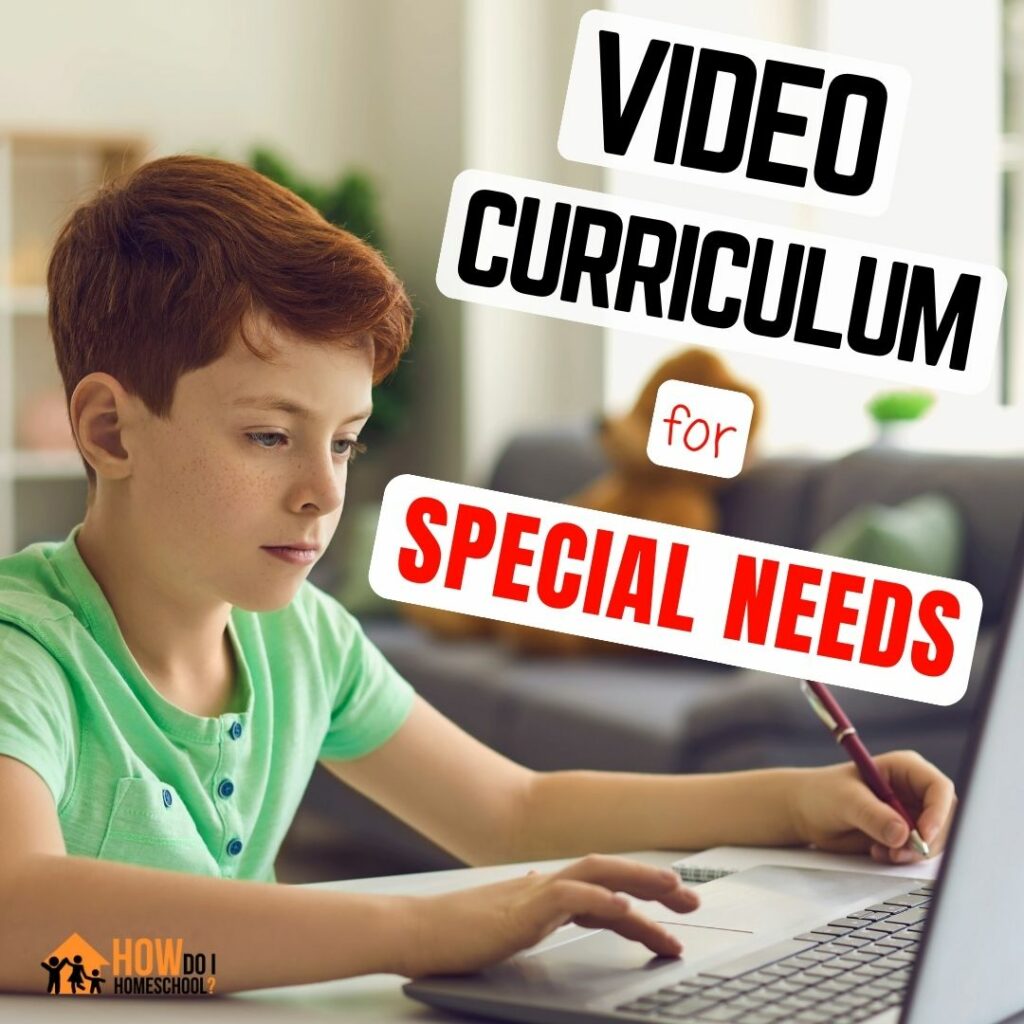Homeschooling can be an excellent option for children with special needs, as it allows for a more personalized and flexible educational approach. However, finding the right curriculum can be challenging, especially for children who may have difficulty with traditional learning methods. That’s why a video-based homeschooling curriculum is becoming an increasingly popular choice for families of children with special needs.

I hope you enjoy reading this blog post. If you want to do my course on how to homeschool, click here.
In recent years, technology has played an increasingly important role in education, and video resources have become an essential tool for homeschooling.
Video resources can provide a visual and interactive way of learning, which can be especially beneficial for children with special needs. They can help to supplement traditional curriculum, provide hands-on learning experiences, and even be used for socialization and collaboration.
In this article, we will explore the benefits of a video-based homeschool curriculum for children with special needs and provide some examples of popular programs that are currently available.
We will also share tips and tricks on how to make the most out of this type of curriculum and how to customize it to meet the unique needs of your child. Whether you’re a parent, a teacher, or a caregiver, this article will provide valuable information on how to create a successful and effective homeschooling experience for children with special needs.

Please Note: This is a guest post.
What is a Video-Based Homeschool Curriculum?
Video-based homeschooling curriculum is a type of education program that uses pre-recorded video lessons to teach various subjects.
These lessons can be watched at the child’s own pace and can be paused, replayed, and reviewed as needed.
This can be especially beneficial for children with special needs who may have trouble keeping up with a traditional classroom setting or who may need extra time to process information.
Benefits of a Video-Based Curriculum
The use of video resources in homeschooling can provide children with special needs access to a wide range of educational materials and can help to improve their learning outcomes.
It can also provide a way for these children to learn at their own pace, which is crucial to their success.
Therefore it is essential to consider the use of video resources in homeschooling children with special needs, which is the focus of this paper.
Planning and Preparation for Using Video-Based Homeschool Curriculum
Step 1: Identify Student Needs
When creating a video-based homeschooling curriculum for a child with special needs, it is important to start by identifying the specific needs of the child.
This will involve assessing the child’s strengths and weaknesses, as well as their learning style and any accommodations that may be necessary.
This information will create a curriculum plan tailored to the child’s unique needs.
Step 2: Choose Resources
Choosing appropriate video resources is also a crucial part of planning and preparation.
There are many different types of video resources available, including educational videos, instructional videos, and even video clips created by other homeschooling families.
It is essential to choose age-appropriate resources, align with the child’s interests, and support the curriculum plan.
Additionally, parents can create clips from the videos to make them more interactive and engaging for their children.
Step 3: Create a Schedule and Plan
Once the appropriate video resources have been selected, the next step is to create a flexible schedule and curriculum plan.
The schedule should be flexible and allow for adjustments as needed and should include time for video-based learning, as well as other activities such as hands-on projects and socialization.
The curriculum plan should also be flexible and should include a variety of video resources that support the child’s learning goals.
Overall, planning and preparation is a crucial step in creating a video-based homeschooling curriculum for a child with special needs. It ensures that the curriculum is tailored to the child’s unique needs, and that the appropriate video resources are selected to support the child’s learning goals.
Implementing a Video-Based Curriculum
Once the planning and preparation stages are complete, the next step is to implement the video-based homeschooling curriculum. This involves incorporating video resources into the daily homeschooling routine, and using them to support the child’s learning goals.
Incorporating video resources into the daily homeschooling routine can be done by setting aside specific times throughout the day for video-based learning.
This could include watching educational videos, following along with instructional videos, or even participating in video conferencing with other homeschooling families.
Parents can create clips from the videos to make it more interactive and engaging for their children. Parents can also use video resources to supplement traditional curricula, such as using videos to explain complex concepts or to provide additional examples of a topic.
Another important aspect of implementation is using video for hands-on learning experiences.
This can be done by using videos to demonstrate how to complete a project or activity, or by using videos to provide virtual field trips or other interactive experiences.
By using video resources in this way, children with special needs can gain a deeper understanding of the material, and can also develop important life skills such as problem-solving and critical thinking.
Finally, it’s important to monitor and evaluate progress throughout the implementation stage. This can be done by keeping track of the child’s progress and noting any areas where improvement is needed. Additionally, parents can use the child’s progress to make adjustments to the curriculum plan as needed.
Overall, monitoring and evaluating progress is essential in ensuring that the child is making progress and that the curriculum is meeting their needs.
Challenges and Solutions
While creating a video-based homeschooling curriculum for a child with special needs can be beneficial, some challenges may arise.
These include managing distractions and maintaining focus, adapting video resources to meet the child’s unique needs, and overcoming technical difficulties.
Managing distractions and maintaining focus can be a challenge when using video resources in homeschooling.
Children with special needs may be more easily distracted than their peers, and may have difficulty focusing on the material presented in the videos. Parents can try to minimize distractions by creating a quiet and comfortable learning environment, and by using videos that are engaging and interactive.
Additionally, parents can create clips from the videos to keep the child focused on the main topic.
Adapting video resources to meet the child’s unique needs can also be a challenge. Some children with special needs may require accommodations such as closed captioning or audio descriptions, while others may need videos to be presented at a slower pace or with simpler language.
Parents can work with their child’s special education team to identify the necessary accommodations and to find appropriate video resources that meet their child’s needs.
Overcoming technical difficulties is another challenge that may arise when using video resources in homeschooling. Parents may encounter issues such as poor internet connectivity, video buffering, or trouble with video conferencing software.
To overcome these challenges, parents can troubleshoot the technical issues and can also reach out to the video resource provider or technical support for assistance.
Overall, while there may be challenges in creating a video-based homeschooling curriculum for a child with special needs, there are also solutions that can be implemented to overcome these challenges.
It’s important to stay flexible and be open to making adjustments as needed to ensure that the child’s learning needs are being met.
Conclusion: Video-Based Homeschool Curriculum
A video-based homeschool curriculum can be an effective way to support the learning needs of children with special needs. Video resources provide a visual and interactive way of learning, which can be especially beneficial for children with special needs. They can help to supplement traditional curricula, provide hands-on learning experiences, and even be used for socialization and collaboration. Overall, a video-based homeschooling curriculum can be a valuable tool for supporting the learning needs of children with special needs. Parents and educators should consider the use of video resources in homeschooling for children with special needs, and continue to explore new and innovative ways to use technology in education.




